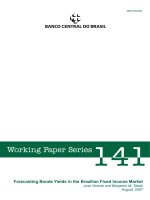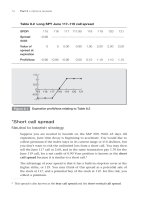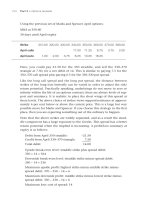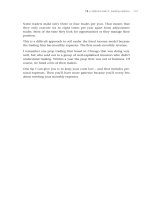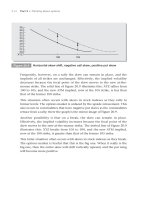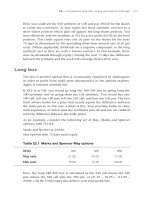Fixed income analysis workbook 2nd edition
Bạn đang xem bản rút gọn của tài liệu. Xem và tải ngay bản đầy đủ của tài liệu tại đây (2.06 MB, 360 trang )
FIXED INCOME
ANALYSIS
WORKBOOK
Second Edition
Frank J. Fabozzi, PhD, CFA
John Wiley & Sons, Inc.
FIXED INCOME
ANALYSIS
WORKBOOK
CFA Institute is the premier association for investment professionals around the world,
with over 85,000 members in 129 countries. Since 1963 the organization has developed
and administered the renowned Chartered Financial AnalystProgram. With a rich history
of leading the investment profession, CFA Institute has set the highest standards in ethics,
education, and professional excellence within the global investment community, and is the
foremost authority on investment profession conduct and practice.
Each book in the CFA Institute Investment Series is geared toward industry practitioners
along with graduate-level finance students and covers the most important topics in the
industry. The authors of these cutting-edge books are themselves industry professionals and
academics and bring their wealth of knowledge and expertise to this series.
FIXED INCOME
ANALYSIS
WORKBOOK
Second Edition
Frank J. Fabozzi, PhD, CFA
John Wiley & Sons, Inc.
Copyright c 2004, 2007 by CFA Institute. All rights reserved.
Published by John Wiley & Sons, Inc., Hoboken, New Jersey.
Published simultaneously in Canada.
No part of this publication may be reproduced, stored in a retrieval system, or transmitted in any form or by any
means, electronic, mechanical, photocopying, recording, scanning, or otherwise, except as permitted under Section
107 or 108 of the 1976 United States Copyright Act, without either the prior written permission of the Publisher, or
authorization through payment of the appropriate per-copy fee to the Copyright Clearance Center, Inc., 222
Rosewood Drive, Danvers, MA 01923, (978) 750-8400, fax (978) 646-8600, or on the Web at www.copyright.com.
Requests to the Publisher for permission should be addressed to the Permissions Department, John Wiley & Sons,
Inc., 111 River Street, Hoboken, NJ 07030, (201) 748-6011, fax (201) 748-6008, or online at
/>Limit of Liability/Disclaimer of Warranty: While the publisher and author have used their best efforts in preparing
this book, they make no representations or warranties with respect to the accuracy or completeness of the contents of
this book and specifically disclaim any implied warranties of merchantability or fitness for a particular purpose. No
warranty may be created or extended by sales representatives or written sales materials. The advice and strategies
contained herein may not be suitable for your situation. You should consult with a professional where appropriate.
Neither the publisher nor author shall be liable for any loss of profit or any other commercial damages, including but
not limited to special, incidental, consequential, or other damages.
For general information on our other products and services or for technical support, please contact our Customer
Care Department within the United States at (800) 762-2974, outside the United States at (317) 572-3993 or fax
(317) 572-4002.
Wiley also publishes its books in a variety of electronic formats. Some content that appears in print may not be
available in electronic formats. For more information about Wiley products, visit our Web site at www.wiley.com.
ISBN-13 978-0-470-06919-6
ISBN-10 0-470-06919-8
Printed in the United States of America.
10 9 8 7 6 5 4 3 2 1
CONTENTS
PART I
Learning Outcomes, Summary Overview, and Problems
CHAPTER 1
Features of Debt Securities
3
Learning Outcomes
Summary Overview
Problems
3
3
5
CHAPTER 2
Risks Associated with Investing in Bonds
Learning Outcomes
Summary Overview
Problems
CHAPTER 3
Overview of Bond Sectors and Instruments
Learning Outcomes
Summary Overview
Problems
CHAPTER 4
Understanding Yield Spreads
Learning Outcomes
Summary Overview
Problems
CHAPTER 5
Introduction to the Valuation of Debt Securities
Learning Outcomes
Summary Overview
Problems
8
8
9
11
15
15
16
19
22
22
23
25
29
29
29
31
vi
Contents
CHAPTER 6
Yield Measures, Spot Rates, and Forward Rates
Learning Outcomes
Summary Overview
Problems
CHAPTER 7
Introduction to the Measurement of Interest Rate Risk
Learning Outcomes
Summary Overview
Problems
CHAPTER 8
Term Structure and Volatility of Interest Rates
Learning Outcomes
Summary Overview
Problems
CHAPTER 9
Valuing Bonds with Embedded Options
Learning Outcomes
Summary Overview
Problems
CHAPTER 10
Mortgage-Backed Sector of the Bond Market
Learning Outcomes
Summary Overview
Problems
CHAPTER 11
Asset-Backed Sector of the Bond Market
Learning Outcomes
Summary Overview
Problems
CHAPTER 12
Valuing Mortgage-Backed and Asset-Backed Securities
Learning Outcomes
Summary Overview
Problems
33
33
34
35
41
41
42
44
49
49
49
52
55
55
55
58
63
63
63
65
73
73
73
78
83
83
83
86
Contents
vii
CHAPTER 13
Interest Rate Derivative Instruments
92
Learning Outcomes
Summary Overview
Problems
CHAPTER 14
Valuation of Interest Rate Derivative Instruments
Learning Outcomes
Summary Overview
Problems
CHAPTER 15
General Principles of Credit Analysis
Learning Outcomes
Summary Overview
Problems
CHAPTER 16
Introduction to Bond Portfolio Management
Learning Outcomes
Summary Overview
Problems
CHAPTER 17
Measuring a Portfolio’s Risk Profile
Learning Outcomes
Summary Overview
Problems
CHAPTER 18
Managing Funds Against a Bond Market Index
Learning Outcomes
Summary Overview
Problems
CHAPTER 19
Portfolio Immunization and Cash Flow Matching
Learning Outcomes
Summary Overview
Problems
92
92
94
98
98
99
100
106
106
107
109
114
114
114
116
119
119
120
122
129
129
130
132
140
140
140
142
viii
Contents
CHAPTER 20
Relative-Value Methodologies for Global Credit Bond
Portfolio Management
Learning Outcomes
Summary Overview
Problems
CHAPTER 21
International Bond Portfolio Management
Learning Outcomes
Summary Overview
Problems
CHAPTER 22
Controlling Interest Rate Risk with Derivatives
Learning Outcomes
Summary Overview
Problems
CHAPTER 23
Hedging Mortgage Securities to Capture Relative Value
Learning Outcomes
Summary Overview
Problems
CHAPTER 24
Credit Derivatives in Bond Portfolio Management
Learning Outcomes
Summary Overview
Problems
144
144
144
146
151
151
152
155
159
159
160
162
167
167
167
169
172
172
172
174
PART II
Solutions
CHAPTER 1
Features of Debt Securities
Solutions
CHAPTER 2
Risks Associated with Investing in Bonds
Solutions
183
183
186
186
ix
Contents
CHAPTER 3
Overview of Bond Sectors and Instruments
Solutions
CHAPTER 4
Understanding Yield Spreads
Solutions
CHAPTER 5
Introduction to the Valuation of Debt Securities
Solutions
CHAPTER 6
Yield Measures, Spot Rates, and Forward Rates
Solutions
CHAPTER 7
Introduction to the Measurement of Interest Rate Risk
Solutions
CHAPTER 8
Term Structure and Volatility of Interest Rates
Solutions
CHAPTER 9
Valuing Bonds with Embedded Options
Solutions
CHAPTER 10
Mortgage-Backed Sector of the Bond Market
Solutions
CHAPTER 11
Asset-Backed Sector of the Bond Market
Solutions
CHAPTER 12
Valuing Mortgage-Backed and Asset-Backed Securities
Solutions
191
191
197
197
201
201
207
207
219
219
225
225
231
231
238
238
251
251
258
258
x
Contents
CHAPTER 13
Interest Rate Derivative Instruments
Solutions
CHAPTER 14
Valuation of Interest Rate Derivative Instruments
Solutions
CHAPTER 15
General Principles of Credit Analysis
Solutions
CHAPTER 16
Introduction to Bond Portfolio Management
Solutions
CHAPTER 17
Measuring a Portfolio’s Risk Profile
Solutions
CHAPTER 18
Managing Funds Against a Bond Market Index
Solutions
CHAPTER 19
Portfolio Immunization and Cash Flow Matching
Solutions
CHAPTER 20
Relative-Value Methodologies for Global Credit Bond
Portfolio Management
Solutions
CHAPTER 21
International Bond Portfolio Management
Solutions
264
264
270
270
281
281
287
287
290
290
298
298
307
307
311
311
316
316
xi
Contents
CHAPTER 22
Controlling Interest Rate Risk with Derivatives
Solutions
CHAPTER 23
Hedging Mortgage Securities to Capture Relative Value
Solutions
CHAPTER 24
Credit Derivatives in Bond Portfolio Management
Solutions
About the CFA Program
324
324
331
331
335
335
343
PART
I
LEARNING OUTCOMES,
SUMMARY OVERVIEW,
AND PROBLEMS
CHAPTER
1
FEATURES OF DEBT
SECURITIES
LEARNING OUTCOMES
After reading Chapter 1 you should be able to:
•
•
•
•
•
•
•
•
•
•
•
•
describe the basic features of a bond (e.g., maturity, par value, coupon rate, bond redeeming
provisions, currency denomination, issuer or investor granted options).
describe affirmative and negative covenants.
identify the various coupon rate structures, such as fixed rate coupon bonds, zero-coupon
bonds, step-up notes, deferred coupon bonds, floating-rate securities.
describe the structure of floating-rate securities (i.e., the coupon formula, interest rate caps
and floors).
define accrued interest, full price, and clean price.
describe the provisions for redeeming bonds, including the distinction between a nonamortizing bond and an amortizing bond.
explain the provisions for the early retirement of debt, including call and refunding
provisions, prepayment options, and sinking fund provisions.
differentiate between nonrefundable and noncallable bonds.
explain the difference between a regular redemption price and a special redemption price.
identify embedded options (call option, prepayment option, accelerated sinking fund
option, put option, and conversion option) and indicate whether each benefits the issuer
or the bondholder.
explain the importance of options embedded in a bond issue.
identify the typical method used by institutional investors to finance the purchase of a
security (i.e., margin or repurchase agreement).
SUMMARY OVERVIEW
•
•
•
•
•
A fixed income security is a financial obligation of an entity (the issuer) who promises to
pay a specified sum of money at specified future dates.
Fixed income securities fall into two general categories: debt obligations and preferred stock.
The promises of the issuer and the rights of the bondholders are set forth in the indenture.
The par value (principal, face value, redemption value, or maturity value) of a bond is the
amount that the issuer agrees to repay the bondholder at or by the maturity date.
Bond prices are quoted as a percentage of par value, with par value equal to 100.
4
Learning Outcomes, Summary Overview, and Problems
•
The interest rate that the issuer agrees to pay each year is called the coupon rate; the coupon
is the annual amount of the interest payment and is found by multiplying the par value by
the coupon rate.
Zero-coupon bonds do not make periodic coupon payments; the bondholder realizes
interest at the maturity date equal to the difference between the maturity value and the
price paid for the bond.
A floating-rate security is an issue whose coupon rate resets periodically based on some
formula; the typical coupon formula is some reference rate plus a quoted margin.
A floating-rate security may have a cap, which sets the maximum coupon rate that will be
paid, and/or a floor, which sets the minimum coupon rate that will be paid.
A cap is a disadvantage to the bondholder while a floor is an advantage to the bondholder.
A step-up note is a security whose coupon rate increases over time.
Accrued interest is the amount of interest accrued since the last coupon payment; in the
United States (as well as in many countries), the bond buyer must pay the bond seller the
accrued interest.
The full price (or dirty price) of a security is the agreed upon price plus accrued interest;
the price (or clean price) is the agreed upon price without accrued interest.
An amortizing security is a security for which there is a schedule for the repayment of
principal.
Many issues have a call provision granting the issuer an option to retire all or part of the
issue prior to the stated maturity date.
A call provision is an advantage to the issuer and a disadvantage to the bondholder.
When a callable bond is issued, if the issuer cannot call the bond for a number of years, the
bond is said to have a deferred call.
The call or redemption price can be either fixed regardless of the call date or based on a call
schedule or based on a make-whole premium provision.
With a call schedule, the call price depends on when the issuer calls the issue.
A make-whole premium provision sets forth a formula for determining the premium that
the issuer must pay to call an issue, with the premium designed to protect the yield of those
investors who purchased the issue.
The call prices are regular or general redemption prices; there are special redemption prices
for debt redeemed through the sinking fund and through other provisions.
A currently callable bond is an issue that does not have any protection against early call.
Most new bond issues, even if currently callable, usually have some restrictions against
refunding.
Call protection is much more absolute than refunding protection.
For an amortizing security backed by a pool of loans, the underlying borrowers typically
have the right to prepay the outstanding principal balance in whole or in part prior to the
scheduled principal payment dates; this provision is called a prepayment option.
A sinking fund provision requires that the issuer retire a specified portion of an issue each
year.
An accelerated sinking fund provision allows the issuer to retire more than the amount
stipulated to satisfy the periodic sinking fund requirement.
A putable bond is one in which the bondholder has the right to sell the issue back to the
issuer at a specified price on designated dates.
A convertible bond is an issue giving the bondholder the right to exchange the bond for a
specified number of shares of common stock at a specified price.
•
•
•
•
•
•
•
•
•
•
•
•
•
•
•
•
•
•
•
•
•
•
•
5
Chapter 1 Features of Debt Securities
•
•
•
•
•
•
The presence of embedded options makes the valuation of fixed income securities complex
and requires the modeling of interest rates and issuer/borrower behavior in order to project
cash flows.
An investor can borrow funds to purchase a security by using the security itself as collateral.
There are two types of collateralized borrowing arrangements for purchasing securities:
margin buying and repurchase agreements.
Typically, institutional investors in the bond market do not finance the purchase of a
security by buying on margin; rather, they use repurchase agreements.
A repurchase agreement is the sale of a security with a commitment by the seller to
repurchase the security from the buyer at the repurchase price on the repurchase date.
The borrowing rate for a repurchase agreement is called the repo rate and while this rate
is less than the cost of bank borrowing, it varies from transaction to transaction based on
several factors.
PROBLEMS
1. Consider the following two bond issues.
Bond A: 5% 15-year bond
Bond B: 5% 30-year bond
Neither bond has an embedded option. Both bonds are trading in the market at the same
yield.
Which bond will fluctuate more in price when interest rates change? Why?
2. Given the information in the first and third columns, complete the table in the second
and fourth columns:
Quoted price
96 1/4
102 7/8
109 9/16
68 11/32
Price per $1 of
par value
Par value
$1,000
$5,000
$10,000
$100,000
Dollar price
3. A floating-rate issue has the following coupon formula:
1-year Treasury rate + 30 basis points with a cap of 7% and a floor of 4.5%
The coupon rate is reset every year. Suppose that at the reset date the 1-year Treasury rate
is as shown below. Compute the coupon rate for the next year:
First reset date
Second reset date
Third reset date
Fourth reset date
Fifth reset date
Sixth reset date
Seventh reset date
Eighth reset date
Ninth reset date
Tenth reset date
1-year Treasury rate
6.1%
6.5%
6.9%
6.8%
5.7%
5.0%
4.1%
3.9%
3.2%
4.4%
Coupon rate
?
?
?
?
?
?
?
?
?
?
6
Learning Outcomes, Summary Overview, and Problems
4. An excerpt from the prospectus of a $200 million issue by Becton, Dickinson and
Company 7.15% Notes due October 1, 2009:
OPTIONAL REDEMPTION We may, at our option, redeem all or any part of
the notes. If we choose to do so, we will mail a notice of redemption to you
not less than 30 days and not more than 60 days before this redemption occurs.
The redemption price will be equal to the greater of: (1) 100% of the principal
amount of the notes to be redeemed; and (2) the sum of the present values of
the Remaining Scheduled Payments on the notes, discounted to the redemption
date on a semiannual basis, assuming a 360-day year consisting of twelve 30-day
months, at the Treasury Rate plus 15 basis points.
a. What type of call provision is this?
b. What is the purpose of this type of call provision?
5. An excerpt from Cincinnati Gas & Electric Company’s prospectus for the 10 1/8% First
Mortgage Bonds due in 2020 states,
The Offered Bonds are redeemable (though CG&E does not contemplate doing
so) prior to May 1, 1995 through the use of earnings, proceeds from the sale
of equity securities and cash accumulations other than those resulting from a
refunding operation such as hereinafter described. The Offered Bonds are not
redeemable prior to May 1, 1995 as a part of, or in anticipation of, any refunding
operation involving the incurring of indebtedness by CG&E having an effective
interest cost (calculated to the second decimal place in accordance with generally
accepted financial practice) of less than the effective interest cost of the Offered
Bonds (similarly calculated) or through the operation of the Maintenance and
Replacement Fund.
What does this excerpt tell the investor about provisions of this issuer to pay off this issue
prior to the stated maturity date?
6. An assistant portfolio manager reviewed the prospectus of a bond that will be issued next
week on January 1 of 2000. The call schedule for this $200 million, 7.75% coupon
20-year issue specifies the following:
The Bonds will be redeemable at the option of the Company at any time in whole
or in part, upon not fewer than 30 nor more than 60 days’ notice, at the following
redemption prices (which are expressed in percentages of principal amount) in
each case together with accrued interest to the date fixed for redemption:
If redeemed during the 12 months beginning January 1,
2000 through 2005
2006 through 2010
2011 through 2012
from 2013 on
104.00%
103.00%
101.00%
100.00%
provided, however, that prior to January 1, 2006, the Company may not redeem
any of the Bonds pursuant to such option, directly or indirectly, from or in
anticipation of the proceeds of the issuance of any indebtedness for money
borrowed having an interest cost of less than 7.75% per annum.
The prospectus further specifies that
The Company will provide for the retirement by redemption of $10 million
of the principal amount of the Bonds each of the years 2010 to and including
Chapter 1 Features of Debt Securities
7
2019 at the principal amount thereof, together with accrued interest to the date
of redemption. The Company may also provide for the redemption of up to
an additional $10 million principal amount . . . annually, . . . such optional right
being non-cumulative.
a.
b.
c.
d.
e.
The assistant portfolio manager made the following statements to a client after
reviewing this bond issue. Comment on each statement. (When answering this question,
remember that the assistant portfolio manager is responding to statements just before the
bond is issued in 2000.)
‘‘My major concern is that if rates decline significantly in the next few years, this issue
will be called by the Company in order to replace it with a bond issue with a coupon
rate less than 7.75%.’’
‘‘One major advantage of this issue is that if the Company redeems it for any reason in
the first five years, investors are guaranteed receiving a price of 104, a premium over
the initial offering price of 100.’’
‘‘A beneficial feature of this issue is that it has a sinking fund provision that reduces the
risk that the Company won’t have enough funds to pay off the issue at the maturity
date.’’
‘‘A further attractive feature of this issue is that the Company can accelerate the payoff
of the issue via the sinking fund provision, reducing the risk that funds will not be
available at the maturity date.’’
In response to a client question about what will be the interest and principal that the
client can depend on if $5 million par value of the issue is purchased, the assistant
portfolio manager responded: ‘‘I can construct a schedule that shows every six months
for the next 20 years the dollar amount of the interest and the principal repayment. It
is quite simple to compute—basically it is just multiplying two numbers.’’
7. There are some securities that are backed by a pool of loans. These loans have a schedule
of interest and principal payments every month and give each borrower whose loan is
in the pool the right to payoff their respective loan at any time at par. Suppose that a
portfolio manager purchased one of these securities. Can the portfolio manager rely on
the schedule of interest and principal payments in determining the cash flow that will be
generated by such securities (assuming no borrowers default)? Why or why not?
8. a. What is an accelerated sinking fund provision?
b. Why can an accelerated sinking fund provision be viewed as an embedded call option
granted to the issuer?
9. The importance of knowing the terms of bond issues, especially those relating to redemption, cannot be emphasized. Yet there have appeared numerous instances of investors,
professional and others, who acknowledge that they don’t read the documentation. For
example, in an Augusts 14, 1983 article published in The New York Times titled ‘‘The
Lessons of a Bond Failure,’’ the following statements were attributed to some stockbrokers:
‘‘But brokers in the field say they often don’t spend much time reading these [official]
statements,’’ ‘‘I can be honest and say I never look at the prospectus. . . . Generally, you
don’t have time to do that,’’ and ‘‘There are some clients who really don’t know what
they buy. . . . They just say, ‘That’s a good interest rate.’ ’’
Why it is important to understand the redemption features of a bond issue?
10. What is meant by an embedded option?
11. a. What is the typical arrangement used by institutional investors in the bond market:
bank financing, margin buying, or repurchase agreement?
b. What is the difference between a term repo and an overnight repo?
CHAPTER
2
RISKS ASSOCIATED WITH
INVESTING IN BONDS
LEARNING OUTCOMES
After reading Chapter 2 you should be able to:
•
•
•
•
•
•
•
•
•
•
•
•
•
•
•
•
•
•
•
explain the various risks associated with investing in bonds (e.g, interest rate risk, call and
prepayment risk, yield curve risk, reinvestment risk, credit risk, liquidity risk, exchange-rate
risk, inflation risk, volatility risk, and event risk).
explain why there is an inverse relationship between changes in interest rates and bond
prices.
identify the relationships among a bond’s coupon rate, yield required by the market, and
price relative to par value (i.e., discount, premium, or par value).
explain how features of a bond (maturity, coupon, and embedded options) affect its interest
rate risk.
identify the relationship among the price of a callable bond, the price of an option-free
bond, and the price of the embedded call option.
explain how the yield level impacts the interest rate risk of a bond.
explain the interest rate risk of a floating-rate security and why its price may differ from par
value.
compute the duration of a bond given its price changes when interest rates change.
interpret the meaning of the duration of a bond.
use duration to approximate the percentage price change of a bond and calculate the new
price if interest rates change.
explain yield curve risk and explain why duration does not account for yield curve risk for
a portfolio of bonds.
explain key rate duration.
identify the factors that affect the reinvestment risk of a security.
explain the disadvantages of a callable and prepayable security to an investor.
explain why prepayable amortizing securities expose investors to greater reinvestment risk
than nonamortizing securities.
describe the types of credit risk: default risk, credit spread risk, and downgrade risk.
explain a rating transition matrix.
distinguish between investment grade bonds and noninvestment grade bonds.
explain what a rating agency does and what is meant by a rating upgrade and a rating
downgrade.
Chapter 2 Risks Associated with Investing in Bonds
•
•
•
•
•
•
9
explain why liquidity risk is important to investors even if they expect to hold a security to
the maturity date.
describe the exchange rate risk an investor faces when a bond makes payments in a foreign
currency.
explain inflation risk.
explain yield volatility, how it affects the price of a bond with an embedded option, and
how changes in volatility affect the value of a callable bond and a putable bond.
describe the various forms of event risk.
describe the components of sovereign risk.
SUMMARY OVERVIEW
•
•
•
•
•
•
•
•
•
•
•
•
•
•
•
•
•
The price of a bond changes inversely with a change in market interest rates.
Interest rate risk refers to the adverse price movement of a bond as a result of a change in
market interest rates; for the bond investor typically it is the risk that interest rates will rise.
A bond’s interest rate risk depends on the features of the bond—maturity, coupon rate,
yield, and embedded options.
All other factors constant, the longer the bond’s maturity, the greater is the bond’s price
sensitivity to changes in interest rates.
All other factors constant, the lower the coupon rate, the greater the bond’s price sensitivity
to changes in interest rates.
The price of a callable bond is equal to the price of an option-free bond minus the price of
any embedded call option.
When interest rates rise, the price of a callable bond will not fall by as much as an otherwise
comparable option-free bond because the price of the embedded call option decreases.
The price of a putable bond is equal to the price of an option-free bond plus the price of
the embedded put option.
All other factors constant, the higher the level of interest rate at which a bond trades, the
lower is the price sensitivity when interest rates change.
The price sensitivity of a bond to changes in interest rates can be measured in terms of
(1) the percentage price change from initial price or (2) the dollar price change from initial
price.
The most straightforward way to calculate the percentage price change is to average the
percentage price change due to the same increase and decrease in interest rates.
Duration is a measure of interest rate risk; it measures the price sensitivity of a bond to
interest rate changes.
Duration can be interpreted as the approximate percentage price change of a bond for a
100 basis point change in interest rates.
The computed duration is only as good as the valuation model used to obtain the prices
when interest rates are shocked up and down by the same number of basis points.
There can be substantial differences in the duration of complex bonds because valuation
models used to obtain prices can vary.
Given the duration of a bond and its market value, the dollar price change can be computed
for a given change in interest rates.
Yield curve risk for a portfolio occurs when, if interest rates increase by different amounts at
different maturities, the portfolio’s value will be different than if interest rates had increased
by the same amount.
10
•
•
•
•
•
•
•
•
•
•
•
•
•
•
•
•
•
•
•
•
•
•
•
Learning Outcomes, Summary Overview, and Problems
A portfolio’s duration measures the sensitivity of the portfolio’s value to changes in interest
rates assuming the interest rates for all maturities change by the same amount.
Any measure of interest rate risk that assumes interest rates change by the same amount for
all maturities (referred to as a ‘‘parallel yield curve shift’’) is only an approximation.
One measure of yield curve risk is rate duration, which is the approximate percentage price
change for a 100 basis point change in the interest rate for one maturity, holding all other
maturity interest rates constant.
Call risk and prepayment risk refer to the risk that a security will be paid prior to the
scheduled principal payment dates.
Reinvestment risk is the risk that interest and principal payments (scheduled payments,
called proceeds, or prepayments) available for reinvestment must be reinvested at a lower
interest rate than the security that generated the proceeds.
From an investor’s perspective, the disadvantages to call and prepayment provisions are
(1) the cash flow pattern is uncertain, (2) reinvestment risk increases because proceeds
received will have to be reinvested at a relatively lower interest rate, and (3) the capital
appreciation potential of a bond is reduced.
Reinvestment risk for an amortizing security can be significant because of the right to
prepay principal and the fact that interest and principal are repaid monthly.
A zero-coupon bond has no reinvestment risk but has greater interest rate risk than a
coupon bond of the same maturity.
There are three forms of credit risk: default risk, credit spread risk, and downgrade risk.
Default risk is the risk that the issuer will fail to satisfy the terms of indebtedness with
respect to the timely payment of interest and principal.
Credit spread risk is the risk that the price of an issuer’s bond will decline due to an increase
in the credit spread.
Downgrade risk is the risk that one or more of the rating agencies will reduce the credit
rating of an issue or issuer.
There are three rating agencies in the United States: Standard & Poor’s Corporation,
Moody’s Investors Service, Inc., and Fitch.
A credit rating is an indicator of the potential default risk associated with a particular bond
issue that represents in a simplistic way the credit rater’s assessment of an issuer’s ability to
pay principal and interest in accordance with the terms of the debt contract.
A rating transition matrix is prepared by rating agencies to show the change in credit ratings
over some time period.
A rating transition matrix can be used to estimate downgrade risk and default risk.
Liquidity risk is the risk that the investor will have to sell a bond below its indicated value.
The primary measure of liquidity is the size of the spread between the bid and ask price
quoted by dealers.
A market bid-ask spread is the difference between the highest bid price and the lowest ask
price from among dealers.
The liquidity risk of an issue changes over time.
Exchange rate risk arises when interest and principal payments of a bond are not
denominated in the domestic currency of the investor.
Exchange rate risk is the risk that the currency in which the interest and principal payments
are denominated will decline relative to the domestic currency of the investor.
Inflation risk or purchasing power risk arises from the decline in value of a security’s cash
flows due to inflation, which is measured in terms of purchasing power.


